Why Your Tyres Matter More Than Your Engine: The Surprising Truth About Road Safety

When it comes to tyres, most drivers have a curious blind spot. We obsess over horsepower, acceleration, and fuel efficiency, yet pay remarkably little attention to those four circles of rubber that actually connect our vehicles to the road. This oversight isn’t just curious—it’s potentially dangerous.
The Forgotten Interface
Think about it this way: your vehicle—that marvel of engineering with its hundreds of sensors and computer systems—ultimately relies on just four hand-sized contact patches to transmit all its power, handle all its braking, and manage all its steering inputs. The sophistication of modern vehicles makes this relationship even more paradoxical.
“Good tyres on a mediocre car will outperform mediocre tyres on a good car in almost every safety-critical situation.”
This counterintuitive truth emerges from a simple physical reality: no matter how advanced your vehicle’s systems, they can only work with the grip that’s available. And that grip comes entirely from your tyres.
The Peculiar Psychology of Tyre Shopping
Why We Choose Poorly
When we shop for tyres, most of us fall into one of three psychological traps:
- We focus almost exclusively on price
- We defer completely to whatever the shop recommends
- We choose based on brand recognition rather than performance characteristics
This decision-making pattern differs dramatically from how we choose the vehicle itself. With cars, we research exhaustively, compare specifications meticulously, and often test drive multiple options. With tyres, we typically spend less time deciding than we would on a restaurant meal.
The 10,000-Hour Rule of Tyre Development
The Hidden Complexity
Modern tyres represent an astonishing compromise between competing demands:
- Grip in both wet and dry conditions
- Low rolling resistance for fuel efficiency
- Durability and longevity
- Comfort and noise reduction
- Heat dissipation
- Handling response
Tyre engineers speak of the “magic triangle” of grip, longevity, and efficiency—improving one typically means sacrificing another. The sophistication required to balance these competing priorities explains why premium tyres often outperform budget options so dramatically.
“The difference between premium and budget tyres in wet braking can be as much as 30% in stopping distance—potentially the difference between a near-miss and a serious collision.”
The Tipping Point of Tyre Wear
The Non-Linear Decline
Tyre performance doesn’t degrade in a linear fashion. Instead, it follows what we might call a performance cliff:
- New tyres typically maintain 90%+ of their performance for the first half of their life
- Performance then begins to decline more rapidly
- Below 3mm of tread (well above the legal minimum of 1.6mm), wet performance drops precipitously
This non-linear relationship creates a false sense of security. Your tyres might seem “fine” until suddenly, in demanding conditions, they aren’t.
The Outlier Effect of Temperature
The Overlooked Variable
Temperature affects tyre performance more dramatically than most drivers realize:
- Cold tyres (below 7°C) have significantly reduced grip
- Overheated tyres (above 100°C) experience temporary grip reduction
- Ambient temperatures influence ideal tyre pressures
This temperature sensitivity explains why Formula One cars use tyre warmers and why racing drivers perform warm-up laps. For everyday driving, it means your tyres perform differently on cold mornings than on hot afternoons.
The Power of Context: Choosing the Right Tyres
The Matching Principle
Different vehicles and driving styles demand different tyre characteristics:
- High-performance vehicles benefit from tyres with superior grip and heat management
- Everyday commuters might prioritize longevity and fuel efficiency
- SUVs require tyres with reinforced structures to handle additional weight
- Electric vehicles benefit from low rolling resistance to maximize range
The right choice depends entirely on your specific context. This explains why the “best” tyre in objective tests might not be the best tyre for your particular situation.
The Broken Window Theory of Tyre Maintenance
Small Problems Become Big Problems
Regular maintenance prevents the cascade of issues that can emerge from neglect:
- Check pressures monthly (including the spare)
- Inspect for visible damage to sidewalls and tread
- Rotate tyres according to manufacturer recommendations
- Ensure proper wheel alignment to prevent uneven wear
Just as broken windows in a neighbourhood can lead to more serious crime, small issues with tyres often presage more significant failures.
The Thin-Slicing Approach to Tyre Assessment
Quick Evaluation Tips
You can learn much about your tyres’ condition in just seconds:
- Run your hand over the tread to feel for feathering (indicates alignment issues)
- Check for even wear across the tyre’s width (uneven wear suggests inflation problems)
- Look for small cracks in the rubber (indicates age-related deterioration)
- Check manufacturing dates (tyres over six years old should be replaced regardless of tread)
These quick assessments can reveal problems long before they become critical.
Conclusion
The relationship between vehicle and road represents one of the most overlooked aspects of driving safety. While we lavish attention on engine performance, entertainment systems, and driver-assistance technologies, we often neglect the four components that deliver all that technology promises. Understanding the remarkable complexity and importance of your tyres might just be the most important safety upgrade you can make—and unlike many vehicle improvements, it doesn’t require advanced technical knowledge or substantial investment. All it takes is paying attention to those four crucial circles of rubber we call tyres.




